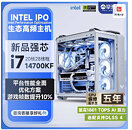- Joined
- Aug 19, 2017
- Messages
- 2,968 (1.06/day)
The long-promised gaming performance uplift for "Arrow Lake" processors is here, but for now, it is only available in China. Called Intel Performance Optimizations (IPO), this feature aims at system integrators rather than end users and offers a balanced approach between stock settings and full manual overclocking, all while preserving warranty coverage. IPO works by applying optimized profiles that adjust a range of CPU and memory parameters. On the CPU side, it fine‑tunes P‑core and E‑core frequencies, ring‑bus speeds, the UPI interconnect, D2D links between tiles, and both PL1 and PL2 power limits. For RAM, IPO raises transfer rates and tightens timings, pushing modules beyond their factory XMP or EXPO profiles. Early results from Chinese OEM Maxsun show that IPO can boost core clocks by about 200 MHz and elevate DDR5‑8000 kits to DDR5‑8400. In gaming tests provided by Maxsun, this translated to roughly a 10 percent uplift in frame rates, an encouraging figure given Arrow Lake's mild launch performance in gaming.
At debut, some Arrow Lake SKUs trailed their "Raptor Lake" predecessors because the chiplet‑based memory controller introduced extra latency and ring‑bus clocks ran slower. Supply‑chain constraints and tariffs have limited IPO's rollout to China so far, where pre‑built systems from vendors like Maxsun are shipping with the feature enabled. Warranty handling stays with the OEM, so users can enjoy the extra headroom without risking hardware support. Behind the scenes, Intel has been issuing firmware and microcode patches since December, most recently microcode 0x114 paired with CSME firmware 19.0.0.1854v2.2, to improve Arrow Lake's efficiency. IPO represents the next step in that effort and could become a model for global "opt‑in" BIOS presets if the pilot proves successful. For now, China is serving as the testing ground for Intel's latest attempt to squeeze more performance out of Arrow Lake. We have to wait and see if Western markets follow soon.


View at TechPowerUp Main Site | Source
At debut, some Arrow Lake SKUs trailed their "Raptor Lake" predecessors because the chiplet‑based memory controller introduced extra latency and ring‑bus clocks ran slower. Supply‑chain constraints and tariffs have limited IPO's rollout to China so far, where pre‑built systems from vendors like Maxsun are shipping with the feature enabled. Warranty handling stays with the OEM, so users can enjoy the extra headroom without risking hardware support. Behind the scenes, Intel has been issuing firmware and microcode patches since December, most recently microcode 0x114 paired with CSME firmware 19.0.0.1854v2.2, to improve Arrow Lake's efficiency. IPO represents the next step in that effort and could become a model for global "opt‑in" BIOS presets if the pilot proves successful. For now, China is serving as the testing ground for Intel's latest attempt to squeeze more performance out of Arrow Lake. We have to wait and see if Western markets follow soon.


View at TechPowerUp Main Site | Source




 . Since that moment intel was going in my view only in the ground, like, brutally.
. Since that moment intel was going in my view only in the ground, like, brutally.
